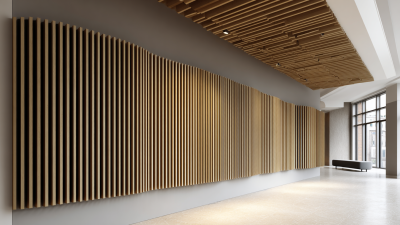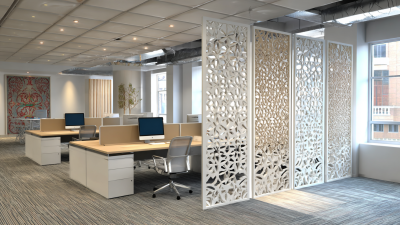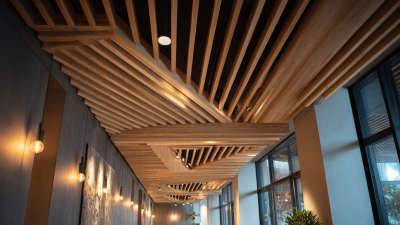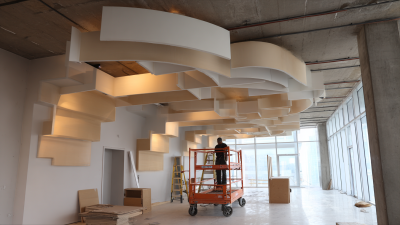Why You Should Choose Grooved Acoustic Panels for Superior Sound Absorption
When it comes to optimizing sound quality in various environments, the choice of materials plays a crucial role. Among the myriad of sound absorption solutions available, Grooved Acoustic Panels stand out as a superior option. These panels not only enhance the aesthetic appeal of a space but also significantly improve acoustic performance by minimizing sound reflections and enhancing clarity. Whether for a bustling office, a serene home theater, or a vibrant music studio, integrating Grooved Acoustic Panels can transform the auditory experience, making it more enjoyable and productive.

The innovative design of Grooved Acoustic Panels allows them to effectively trap and dissipate sound waves, reducing unwanted noise and reverberation. This makes them particularly suitable for locations that demand quiet and clarity, such as conference rooms and recording studios. By choosing Grooved Acoustic Panels, users can ensure a more comfortable and focused environment, enabling better communication and creativity. In this article, we will delve into the top ten reasons why opting for Grooved Acoustic Panels will elevate your sound absorption strategy, emphasizing their unique benefits and practical applications.
The Science Behind Sound Absorption: Understanding Acoustic Panel Materials
Acoustic panels have increasingly become a popular solution for enhancing sound quality in various environments, such as studios, offices, and homes. Understanding the science behind sound absorption is essential when selecting the right materials for these panels. Generally, sound waves interact with different materials in distinct ways, leading to variations in their absorption capabilities. Materials like foam, fabric, and wood can significantly impact how sound is absorbed, making it vital to choose wisely based on the intended use of the space.
Among the various options available, grooved acoustic panels offer a unique advantage. The grooves increase the surface area, allowing for greater interaction with sound waves. This structure helps to disperse sound more efficiently, reducing echoes and minimizing noise levels. Additionally, by combining various materials and designs, grooved panels can be strategically placed to target specific frequencies, ensuring optimal sound quality.
Understanding these scientific principles can guide individuals and businesses in making informed decisions regarding their acoustic needs, ultimately leading to a more comfortable and productive auditory environment.
Key Benefits of Grooved Acoustic Panels for Enhanced Acoustic Performance
Grooved acoustic panels are becoming increasingly popular in various settings, from recording studios to open office spaces, due to their outstanding sound absorption capabilities. The grooves in these panels are designed to disrupt sound waves, minimizing echo and creating a more controlled acoustic environment. This is particularly beneficial in large or hard-surfaced areas where sound can bounce off walls and ceilings, leading to a distracting auditory experience.

One significant advantage of grooved acoustic panels is their aesthetic appeal. They come in various designs, colors, and finishes, allowing them to blend seamlessly into any interior decor. When selecting panels, consider the overall design theme of your space and ensure that the colors and styles complement your existing decor.
Tip: For optimal performance, it’s crucial to strategically position the panels in areas where sound reflection is most prominent. Additionally, combining these panels with soft furnishings can further enhance sound absorption and contribute to a more pleasant acoustic experience.
Comparative Analysis: Grooved Panels vs. Flat Panels in Sound Control
When comparing grooved acoustic panels to flat panels in sound control, several key factors emerge that highlight the advantages of grooved designs. Grooved panels are engineered to enhance sound absorption by creating a complex surface that traps and dissipates sound waves more effectively than their flat counterparts. The unique structure of grooved panels allows for the modification of sound wave paths, reducing echoes and improving overall acoustic performance in various environments, such as offices, studios, and public spaces.

Moreover, the aesthetic versatility of grooved acoustic panels adds to their appeal. Available in various designs, colors, and finishes, these panels can blend seamlessly with existing interior décor while also serving their primary function of sound control. In contrast, flat panels often lack this design versatility, making them less suitable for environments where aesthetics and acoustic performance need to coexist. Therefore, for those seeking superior sound absorption coupled with design appeal, grooved acoustic panels present a compelling choice over traditional flat panels.
Installation Tips for Maximizing Effectiveness of Grooved Acoustic Panels
When installing grooved acoustic panels, maximizing their effectiveness hinges on careful placement and mounting techniques. According to a report by Acoustics First, strategically positioning these panels at first reflection points dramatically enhances sound absorption, reducing unwanted echoes in any space. These reflection points can be identified using mirrors during sound checks, allowing for optimal alignment that targets the core acoustic challenges of the environment.
Furthermore, the distance from the wall and the angles at which the panels are installed can significantly influence their performance. Research by the National Institute of Standards and Technology (NIST) indicates that maintaining a gap of at least 2 inches between the panel and the wall can improve low-frequency absorption by up to 20%. Additionally, experimenting with varying angles can help diffuse sound waves more effectively, catering to a room’s unique acoustics. Overall, these installation tips are crucial for leveraging the full potential of grooved acoustic panels.
Cost-Effectiveness: Long-Term Investment in Sound Quality with Grooved Panels
When considering sound absorption solutions, grooved acoustic panels stand out not only for their effectiveness but also for their cost-effectiveness, making them a long-term investment in acoustics. According to a study by the Acoustical Society of America, well-designed acoustic panels can improve sound quality in environments like offices and concert halls by as much as 50%. This significant enhancement in auditory experience can lead to increased productivity and overall happiness in workspaces, making the initial expense of grooved panels a wise choice.
Furthermore, the durability of these panels contributes to their cost-effectiveness. Many grooved acoustic panels are designed to last for years without losing their sound absorption properties. Research indicates that businesses can save 20-30% on reverb reduction maintenance costs over a decade by investing in high-quality panels upfront. In comparison to traditional acoustic solutions that might require frequent replacements, grooved panels prove to be a superior, budget-friendly option for enhancing sound quality in any setting, from residential to commercial spaces.
Related Posts
-

Choosing the Top 5 Manufacturers for Best Slat Wall Acoustic Panels Worldwide
-

Explore Innovations in Interior Acoustic Panels at China Import and Export Fair 2025
-

Innovative Uses of Acoustic Partition Panels in Modern Workspace Design for Enhanced Productivity
-

Exploring the Benefits of Acoustic Ceiling Wood for Enhanced Sound Absorption in Modern Homes
-

Revamp Your Space with Slat Wall Acoustic Panels for Ultimate Sound Control
-

The Science Behind Curved Acoustic Panels Improving Sound Quality in Modern Spaces
-

Phone
-

E-mail
-

wechat
wechat

-

whatsapp
whatsapp


